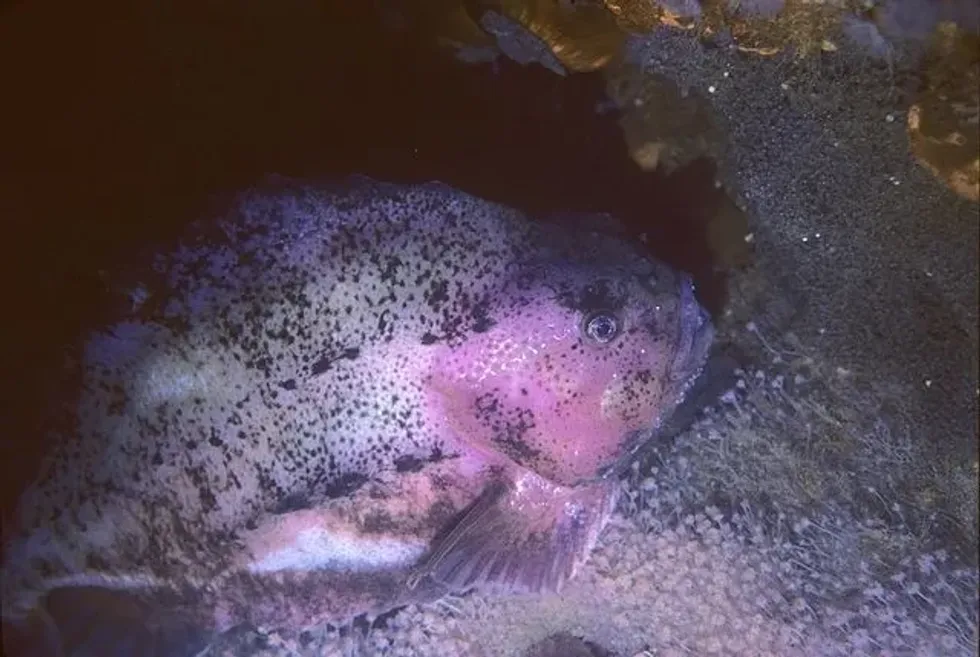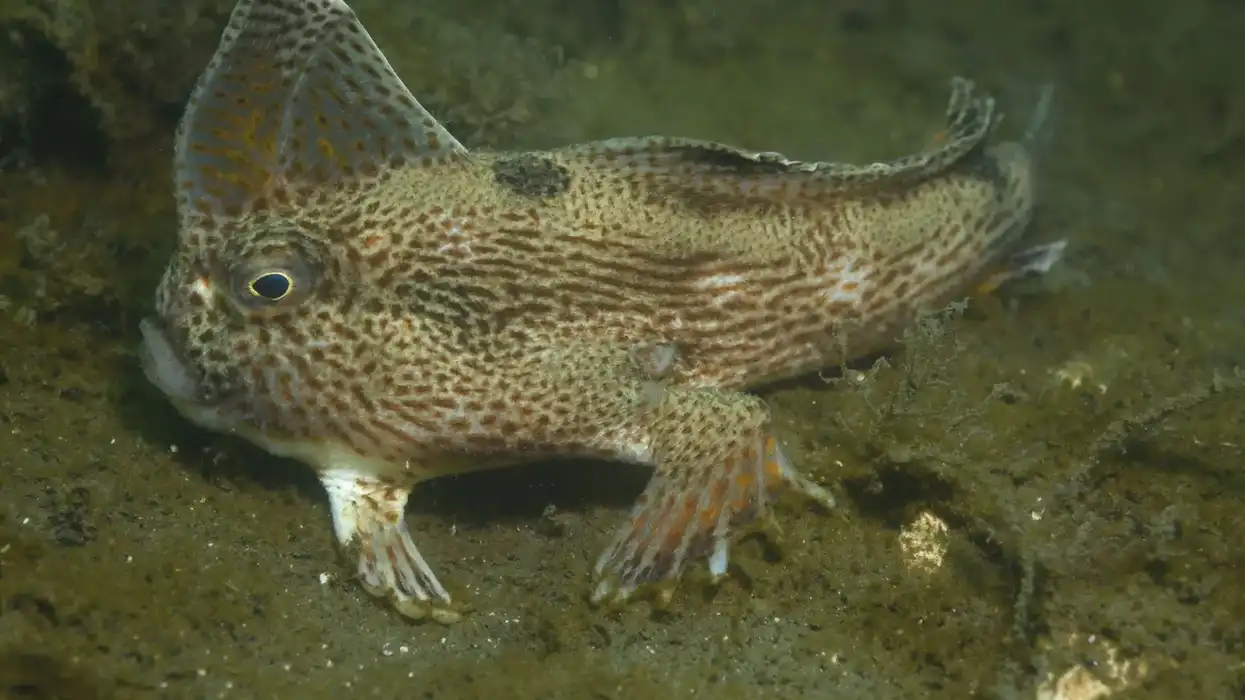The smooth lumpfish (Aptocyclus ventricosus) is a member of the lumpfish family whose genus is Aptocyclus. The species is found mainly in North Pacific and grows to a length of 17 in (43 cm).
It is a marine fish species without having any tubercles or scales on their body. The lumpsucker has pectoral fins that are broad and large in structure. The cold waters of the North Pacific suit the lumpsucker very much.
The Pacific spiny lumpsucker and Cyclopterus lumpus also belong to the family of lumpsucker species. Among these, the Pacific spiny lumpsucker is found in the depths of the North Atlantic.
It is also known as smooth lumpsucker due to the presence of the ‘sucker’ or modified pelvic fin that is in the shape of discs. Lumpfish use these to cling to the surface of rocks. A unique feature of the smooth lumpfish is the ability to inflate itself with water which can be assumed to be a defense mechanism.
If you like this article you can even check out facts about plaice and blue runner.
Smooth Lumpfish Interesting Facts
What type of animal is a smooth lumpfish?
The smooth lumpsucker (Aptocyclus ventricosus) is a species of deep-sea fish that belongs to the family Cyclopteridae and genus Aptocyclus.
What class of animal does a smooth lumpfish belong to?
Like other ray-finned fishes such as the Pacific cod, stargazers, and porcupine fish, the smooth lumpsucker also belongs to the class of Actinopterygii of animals.
How many smooth lumpfish are there in the world?
Since there is not much data available on the number of smooth lumpfish in the world, the exact population of this fish is not known. It is known that the lumpsucker is found in the North Pacific region.
Where does a smooth lumpfish live?
The North Pacific Ocean is the area where you can find the smooth lumpsucker. The lumpfish can be found deep down in the ocean as far as 5600 ft (1706.8 m).
Inside the North Pacific, the species can be found more in the Aleutian Basin region. Species of lumpfish inhabit British Columbia, Pusan, and even Canada.
A number of them have also been observed in North Korea located outside of the Sea of Okhotsk. The southeast region of Mathieson Channel is also favored by the smooth lumpfish for residing.
All of these come under the North Pacific Ocean. Some other species of lumpsuckers such as the Pacific spiny lumpsucker can also be found in the cold waters of the North Atlantic and the Arctic Ocean.
What is a smooth lumpfish's habitat?
The smooth lumpsucker is a deep-sea species of fish that is found at depths ranging between 2008-5577 ft (612-1699.8 m). Though rare, people have observed the species as close as 16 ft (4.8 m) from the surface.
The habitat of the lumpsucker is mostly in the mid-water and near-bottom layers of the North Pacific. Migration of lumpsuckers occurs twice during the year. It moves to shallower waters during the summer and to deeper waters when the cold season arrives.
Who do smooth lumpfish live with?
The lumpsucker is a solitary fish and you will find it living alone at most times of the year. It is only during the breeding season that the lumpsucker comes together.
How long does a smooth lumpfish live?
The exact lifespan of the smooth lumpsucker is not known. Since some species of the lumpsucker family have been observed to live for 12-13 years, we can assume the same for the smooth lumpsucker.
How do they reproduce?
During the breeding season, the smooth lumpfish species come together. Reproduction for the Iteroparous gonochoristic species occurs in a group synchronous method.
The females spawn a single batch of eggs in each breeding season. Spawning migration is observed in the species as they go from deep seas to coastal zones.
Breeding takes place above a rocky bottom surface at a place where the sea is not too deep, about 33 ft (10 m). The roe develops a thick envelope around them to protect themselves from mechanical damage while they are still in stages of development near the coast.
The male takes care of and protects the egg clusters. After an incubation period of about 40 days, hatching of the eggs takes place.
What is their conservation status?
The IUCN Red List of Threatened Species has Not Evaluated the conservation status of the smooth lumpfish species. A steady decline in the number of the lumpsucker in North Pacific is due to the eggs or roe being used as food by humans.
Smooth Lumpfish Fun Facts
What do smooth lumpfish look like?
The smooth lumpfish (Aptocyclus ventricosus), a member of the Cyclopteridae family and belonging to the genus Aptocyclus, has brownish-gray skin with dark spots that are present dorsally. The ventral portion is muddy gray in color.
The body of the fish consists of naked skin with no presence of any tubercles or scales. The number of anal soft rays is between seven and nine while the number of dorsal soft rays might be eight or nine.
The fish does not have any anal spine, nor any dorsal spine. The caudal fin is spherical in shape while the pectoral fins are largely broad-shaped.
The pelvic fins of the smooth lumpfish are modified in the shape of a ‘sucker’ or a clinging disc that clings to the surface of rocks under the water. The disc has a thick margin that is located near the ventral surface of the fish’s body.
This disc cannot be seen clearly in the young ones and become well developed as they mature into adults. Embedded under the skin completely is the first dorsal fin of the fish.
 We've been unable to source an image of smooth lumpfish and have used an image of a white sucker instead. If you are able to provide us with a royalty-free image of smooth lumpfish, we would be happy to credit you. Please contact us at hello@kidadl.com.
We've been unable to source an image of smooth lumpfish and have used an image of a white sucker instead. If you are able to provide us with a royalty-free image of smooth lumpfish, we would be happy to credit you. Please contact us at hello@kidadl.com.
How cute are they?
The smooth lumpfish is definitely a cute animal. The grayish-colored body of the fish and its shape are contributing factors to its cuteness.
How do they communicate?
The smooth lumpsucker is a solitary animal. There is no need for any sort of communication except during reproduction.
How big is a smooth lumpfish?
The body of a smooth lumpfish grows to a length in the range of 2.4-17.3 in (6-44 cm). If we compare it to other marine fish species such as the milkfish, the lumpsucker turns out to be smaller between the two.
How fast can a smooth lumpfish swim?
The smooth lumpfish is not known for its swimming speed and we can conclude from this fact that the species is not a good swimmer. It prefers remaining in one place.
How much does a smooth lumpfish weigh?
The weight of smooth lumpsuckers falls in the range of 1.76-148.16 oz (49.8-4200.26 g). Compared to this, the lumpfish (Cyclopterus lumpus) weighs about 176 oz (4989.5 g).
What are the male and female names of the species?
The males and the females of this species have no specialized names.
What would you call a baby smooth lumpfish?
A baby smooth lumpsucker is known as a larva.
What do they eat?
The diet of smooth lumpsuckers includes marine mammals, mainly ctenophores and medusa. At times they have also been seen to eat crustaceans and pelagic polychaetes as part of their diet. Predators like the sablefish and the Pacific cod prey on the lumpsucker.
Are they dangerous?
Generally, the smooth lumpfish is not considered a threat to humans but the males might show some aggression if their eggs are in danger.
Would they make a good pet?
The smooth lumpfish is best suited for a life in the sea although some people do keep them as pets.
Did you know...
The smooth lumpfish is the only fish available in its genus.
The Cyclopterus lumpus is considered a delicacy but the Aptocyclus ventricosus is not as popular as food. The roe is eaten in many places.
How do lumpfish protect themselves?
The body of the lumpfish has modified pelvic fins that cling to rocks under the water. When they are in danger, the fish attaches itself to these rocks.
What makes lumpfish unique?
The lumpfish has no tubercles on their body and the pelvic fins have been modified to attach to the surface. The first dorsal fins of the fish are completely embedded beneath the skin of the fish. Another unique feature of the fish is the presence of nine soft rays, both dorsal and anal.
Here at Kidadl, we have carefully created lots of interesting family-friendly animal facts for everyone to discover! For more relatable content, check out these devil fish facts and candiru facts for kids.
You can even occupy yourself at home by coloring in one of our free printable sunfish coloring pages.
Main image by Derek Keats from Johannesburg, South Africa.
We've been unable to source an image of smooth lumpfish and have used an image of a lumpfish instead. If you are able to provide us with a royalty-free image of smooth lumpfish, we would be happy to credit you. Please contact us at hello@kidadl.com.




 We've been unable to source an image of smooth lumpfish and have used an image of a white sucker instead. If you are able to provide us with a royalty-free image of smooth lumpfish, we would be happy to credit you. Please contact us at hello@kidadl.com.
We've been unable to source an image of smooth lumpfish and have used an image of a white sucker instead. If you are able to provide us with a royalty-free image of smooth lumpfish, we would be happy to credit you. Please contact us at hello@kidadl.com.



